Determination of 3D Displacements of Drainage Networks Extracted from Digital Elevation Models (DEMs) Using Linear-Based Methods
Abstract
:1. Introduction
2. Methodology
2.1. Obtaining of the Datasets to Be Used
2.2. Selection and Preparation of the Linestrings
- Selection of linestrings: The drainage networks extracted from DEMs can be composed of a great quantity of channels. Therefore, a process for selecting elements is needed in order to establish the linestrings of both datasets to be used. Obviously this selection of elements will depend on the purpose of the study to be performed, but in general we consider that this process will initially be based on the availability of elements in the CTR1. In this sense, the origin of the CTR1 dataset plays a great importance in the selection of the linestrings to be used:
- DEM source (Option 1): In this case we must consider that the density of the drainage network obtained depends on the threshold of the accumulated area used (e.g., cells with more than 50 cells flowing into them). As the threshold value is increased, the density of the drainage network decreases [5]. A more detailed analysis of this aspect was provided by Tarboton et al. [6] and Chen et al. [44]. Alternatively to the use of this threshold, it is possible to use an auxiliary vector source (VCT in Figure 1) as selection mask by the automatic selection of the CTR1 linestrings which are included in a proximity area (defined by a buffer) which encloses the auxiliary VCT linestrings.
- Vector source (Option 2): In this case we must consider the scale of the cartographic source and the goal of the study in order to determine the linestrings to be selected. Some attributes included in the vector source can be used to determine the level of importance of the drainage channels to be selected, such as the channel order. As an example, this order can be obtained using the Strahler [45] algorithm. In a similar way to the case of Option 1, another auxiliary vector source (VCT in Figure 1) can also be used as selecting mask.
A set of linestrings of CTR2A is selected in order to establish the sample of channels to be analyzed. The selection process also includes the determination of the linestrings of the dataset to be assessed (LIN1) which are related to those selected reference linestrings (CTR2A). Here there are several manual or automatic possibilities. We suggest an automatic solution based on the generation of a buffer around the CTR2A linestrings and the spatial intersection of the LIN1 linestrings included in this proximity area. The selection of the width of the buffer must consider the spatial resolution of the DEM and the characteristics of the drainage networks to be studied. We must avoid removing those sections of channels where there are spatial changes greater than this width. Thus, a previous visual analysis of all datasets is recommended in order to determine this width. As a result of this selection, we obtain a dataset to be assessed (LIN2A) and a reference dataset (CTR2A) where there are relationships of proximity between the linestring included in both of them. - After the selection of data, an editing is carried out in order to prepare both datasets for an automatic assessment. In this editing process, the linestrings are joined, trimmed or deleted in order to obtain two sets of linestrings which have a certain level of spatial and topological coherence. As an example, two linestrings of LIN2A which correspond to one of CTR2A are joined. The edition stage generates LIN2B and CTR2B datasets.
- Finally, a matching process is performed in order to establish a unique relationship of each linestring of the LIN2B dataset to one linestring of the CTR2B dataset. The definitive datasets of linestrings are called LIN2C and CTR2C in Figure 1. Both processes of editing and matching can be implemented manually or automatically, as an example using those algorithms described by Mozas and Ariza [42] and Xavier et al. [46].
2.3. Application of the Positional Assessment Methods
2.4. Analysis of the Results
3. Application
4. Results and Discussion
- Slope (Figure 7a,b): Slope has a great influence on the height error, depending on the planimetric accuracy. In this context, some studies [25,53,54] have analyzed these dependencies between vertical and horizontal errors on contour lines based on the tangent of the slope (by a regression using Koppe’s formula). The values of HDM3D (Figure 7a) show a tendency of reduction of maximum displacements with the slope, although there are some specific cases which show some peaks. We have to note that the results of Hausdorff distance-based methods have a large sensibility to great displacements even though these displacements were restricted to a small section of the linestring. On the other hand, the mean values of displacements analyzed using VIM3D (Figure 7b) show a more uniform behavior with a general reduction of about 20% of displacements with the increase of slopes until the 5–10% case and after that, a stabilization or minor increase of displacements with the slope. This behavior was caused by the planimetric uncertainty of channels in flat zones caused by the algorithm applied in the extraction process.
- Stream order (Figure 7c,d): In the case of HDM3D, the distribution of the results by stream order shows irregular behavior without clear tendencies. On the other hand, the results of VIM3D show an increase of displacements with the stream order in both datasets, and more specifically of about 40% in the RED77 case and about 25% in the RED10 case. The general trend shown by this method is accorded to the extraction algorithm if we take into account that the axes of channels are supposedly worse-defined with the increase of the stream order because of the geomorphologic conditions of the terrain (flatness).
- Drainage network (Figure 7e,f): In these cases (HDM3D and VIM3D), there is a similar behavior in both datasets with lower variability of the values obtained. We cannot establish a relationship between the displacement obtained and the distribution of drainage networks applied.
5. Conclusions
Author Contributions
Conflicts of Interest
References
- National Aeronautics and Space Administration (NASA). Advanced Spaceborne Thermal Emission and Reflection Radiometer (ASTER) Global Digital Elevation Model Version 2 (GDEM V2). Available online: http://asterweb.jpl.nasa.gov/GDEM.ASP (accessed on 12 June 2017).
- Wohl, E. Hydrology: Streams. In River Ecosystem Ecology: A Global Perspective; Likens, G.E., Ed.; Academic Press: San Diego, CA, USA, 2010; pp. 23–31. [Google Scholar]
- O’Callaghan, J.F.; Mark, D.M. The extraction of drainage networks from digital elevation data. Comput. Vis. Graph. 1984, 28, 323–344. [Google Scholar] [CrossRef]
- Peucker, T.K.; Douglas, D.H. Detection of surface-specific points by local parallel processing of discrete terrain elevation data. Comput. Graph. Image Process. 1975, 4, 375–387. [Google Scholar] [CrossRef]
- Jenson, S.K.; Domingue, J.O. Extracting topographic structure from digital elevation data for geographic information system analysis. Photogramm. Eng. Remote Sens. 1988, 54, 1593–1600. [Google Scholar]
- Tarboton, D.G.; Bras, R.L.; Rodriguez-Iturbe, I. On the extraction of channel networks from digital elevation data. Hydrol. Process. 1991, 5, 81–100. [Google Scholar] [CrossRef]
- Tribe, A. Automated recognition of valley lines and drainage networks from grid digital elevation models: A review and a new method. J. Hydrol. 1992, 139, 263–293. [Google Scholar] [CrossRef]
- Soille, P.; Gratin, C. An efficient algorithm for drainage network extraction on DEMs. J. Vis. Commun. Image Represent. 1994, 5, 181–189. [Google Scholar] [CrossRef]
- Martz, L.W.; Garbrecht, J. Automated recognition of valley lines and drainage networks from grid digital elevation models: A review and a new method—Comment. J. Hydrol. 1995, 167, 393–396. [Google Scholar] [CrossRef]
- Hou, K.; Sun, J.; Yang, W.; Sun, T.; Wang, Y.; Ma, S. Automatic Extraction of Drainage Networks from DEMs Base on Heuristic Search. J. Softw. 2011, 6, 1611–1618. [Google Scholar] [CrossRef]
- Federal Geographic Data Committee (FGDC). Geospatial Positioning Accuracy Standards Part 3: National Standard for Spatial Data Accuracy; US Federal Geographic Data Committee: Reston, VA, USA, 1998.
- United States Geological Survey (USGS). DEM Standards, 1998. Specifications (Part-2), Standards for Digital Elevation Models, National Mapping Program. Standards; United States Geological Survey: Reston, VA, USA, 1998.
- American Society for Photogrammetry and Remote Sensing (ASPRS). ASPRS Positional Accuracy Standards for Digital Geospatial Data. Photogramm. Eng. Remote Sens. 2015, 81, 1–26. [Google Scholar] [CrossRef]
- Li, Z. A comparative study of the accuracy of digital terrain models (DTMs) based on various data models. ISPRS J. Photogramm Remote Sens. 1994, 49, 2–11. [Google Scholar] [CrossRef]
- Hirano, A.; Welch, R.; Lang, H. Mapping from ASTER stereo image data: DEM validation and accuracy assessment. ISPRS J. Photogramm. Remote Sens. 2003, 57, 356–370. [Google Scholar] [CrossRef]
- Miliaresis, G.C.; Paraschou, C.V. Vertical accuracy of the SRTM DTED level 1 of Crete. Int. J. Appl. Earth Obs. 2005, 7, 49–59. [Google Scholar] [CrossRef]
- Aguilar, F.J.; Mills, J.P. Accuracy assessment of LiDAR-derived Digital Elevation Models. Photogramm. Rec. 2008, 23, 148–169. [Google Scholar] [CrossRef]
- Höhle, J.; Höhle, M. Accuracy assessment of digital elevation models by means of robust statistical methods. ISPRS J. Photogramm. Remote Sens. 2009, 64, 398–406. [Google Scholar] [CrossRef]
- Mukherjee, S.; Joshi, P.K.; Mukherjee, S.; Ghosh, A.; Garg, R.D.; Mukhopadhyay, A. Evaluation of vertical accuracy of open source Digital Elevation Model (DEM). Int. J. Appl. Earth Obs. 2013, 21, 205–217. [Google Scholar] [CrossRef]
- McMaster, K.J. Effects of digital elevation model resolution on derived stream network positions. Water Resour. Res. 2002, 38, 13–19. [Google Scholar] [CrossRef]
- Pirotti, F.; Tarolli, P. Suitability of LiDAR point density and derived landform curvature maps for channel network extraction. Hydrol. Process. 2010, 24, 1187–1197. [Google Scholar] [CrossRef]
- Monteiro, E.V.; Carneiro, A.D.F.S.; Fonte, C.C.; de Lima, J.L.; Santos, R.L.R.; Pólo, I.I. Assessing positional accuracy of drainage networks extracted from ASTER, SRTM and OpenStreetMap. In Proceedings of the 18th AGILE International Conference on Geographic Information Science, Lisboa, Portugal, 9–12 June 2015; Bacao, F., Santos, M.Y., Painho, M., Eds.; pp. 1–5. [Google Scholar]
- Reinoso, J.F. A priori horizontal displacement (HD) estimation of hydrological features when versioned DEMs are used. J. Hydrol. 2010, 384, 130–141. [Google Scholar] [CrossRef]
- Mozas, A.; Ureña, M.A.; Ariza, F.J. Methodology for analyzing multi-temporal planimetric changes of river channels. In Proceedings of the 26th International Cartographic Conference, Dresde, Germany, 25–30 August 2013; Buchroithner, M.F., Ed.; pp. 25–30. [Google Scholar]
- Mozas-Calvache, A.; Ureña-Cámara, M.; Pérez-García, J.L. Accuracy of contour lines using 3D bands. Int. J. Geogr. Inf. Sci. 2013, 27, 2362–2374. [Google Scholar] [CrossRef]
- Perkal, J. On epsilon length. Bulletin de l’Academie Polonaise des Sciences 1956, 4, 399–403. [Google Scholar]
- Chrisman, N.R. A theory of cartographic error and its measurement in digital bases. In Proceedings of the Fifth International Symposium on Computer-Assisted Cartography, Crystal City, Arlington, VA, USA, 22–28 August 1982; Foreman, J., Ed.; pp. 159–168. [Google Scholar]
- Blakemore, M. Generalisation and error in spatial data bases. Cartographica 1984, 21, 131–139. [Google Scholar] [CrossRef]
- Caspary, W.; Scheuring, R. Positional accuracy in spatial databases. Comput. Environ. Urban. Syst. 1993, 17, 103–110. [Google Scholar] [CrossRef]
- Leung, Y.; Yan, J. A locational error model for spatial features. Int. J. Geogr. Inf. Sci. 1998, 12, 607–620. [Google Scholar] [CrossRef]
- Shi, W. A generic statistical approach for modelling error of geometric features in GIS. Int. J. Geogr. Inf. Sci. 1998, 12, 131–143. [Google Scholar] [CrossRef]
- Shi, W.; Liu, W. A stochastic process-based model for the positional error of line segments in GIS. Int. J. Geogr. Inf. Sci. 2000, 14, 51–66. [Google Scholar] [CrossRef]
- Delafontaine, M.; Nolf, G.; Van de Weghe, N.; Antrop, M.; de Maeyer, P. Assessment of sliver polygons in geographical vector data. Int. J. Geogr. Inf. Sci. 2009, 23, 719–735. [Google Scholar] [CrossRef]
- McMaster, R.B. A statistical analysis of mathematical measures for linear simplification. Am. Cartogr. 1986, 13, 103–116. [Google Scholar] [CrossRef]
- Skidmore, A.K.; Turner, B.J. Map Accuracy Assessment Using Line Intersect Sampling. Photogramm. Eng. Remote Sens. 1992, 58, 1453–1457. [Google Scholar]
- Abbas, I.; Grussenmeyer, P.; Hottier, P. Contrôle de la planimétrie d’une base de données vectorielles: Une nouvelle méthode basée sur la distance de Haussdorff: La méthode du contrôle linéaire. Bulletin Societé Française de Photogrammétrie et Télédétection 1995, 137, 6–11. [Google Scholar]
- Goodchild, M.F.; Hunter, G.J. A simple positional accuracy measure for linear features. Int. J. Geogr. Inf. Sci. 1997, 11, 299–306. [Google Scholar] [CrossRef]
- Tveite, H.; Langaas, S. An accuracy assessment method for geographical line data sets based on buffering. Int. J. Geogr. Inf. Sci. 1999, 13, 27–47. [Google Scholar] [CrossRef]
- Mozas-Calvache, A.T.; Ariza-López, F.J. New method for positional quality control in cartography based on lines. A comparative study of methodologies. Int. J. Geogr. Inf. Sci. 2011, 25, 1681–1695. [Google Scholar] [CrossRef]
- Mozas-Calvache, A.; Ariza-López, F.J. Adapting 2D positional control methodologies based on linear elements to 3D. Surv. Rev. 2015, 47, 195–201. [Google Scholar] [CrossRef]
- Gil de la Vega, P.; Ariza-López, F.J.; Mozas-Calvache, A.T. Models for positional accuracy assessment of linear features: 2D and 3D cases. Surv. Rev. 2016, 48, 347–360. [Google Scholar] [CrossRef]
- Mozas, A.T.; Ariza, F.J. Methodology for positional quality control in cartography using linear features. Cartogr. J. 2010, 47, 371–378. [Google Scholar] [CrossRef]
- De Jager, A.L.; Vogt, J.V. Development and demonstration of a structured hydrological feature coding system for Europe. Hydrol. Sci. J. 2010, 55, 661–675. [Google Scholar] [CrossRef]
- Chen, J.; Lin, G.; Yang, Z.; Chen, H. The relationship between DEM resolution, accumulation area threshold and drainage network indices. In Proceedings of the IEEE 18th International Conference on Geoinformatics, Beijing, China, 18–20 June 2010; Liu, Y., Chen, A., Eds.; pp. 1–5. [Google Scholar]
- Strahler, A.N. Hypsometric (area-altitude) analysis of erosional topography. Geol. Soc. Am. Bull. 1952, 63, 1117–1142. [Google Scholar] [CrossRef]
- Xavier, E.; Ariza-López, F.J.; Ureña-Cámara, M.A. A survey of measures and methods for matching geospatial vector datasets. ACM Comput. Surv. 2016, 49, 39. [Google Scholar] [CrossRef]
- Instituto Geográfico Nacional (IGN). Download Center. Available online: http://centrodedescargas.cnig.es/CentroDescargas/ (accessed on 12 June 2017).
- Red de Información Ambiental de Andalucía (REDIAM). Available online: http://www.juntadeandalucia.es/medioambiente/site/rediam (accessed on 12 June 2017).
- Instituto de Estadística y Cartografía de Andalucía (IECA). Available online: https://www.juntadeandalucia.es/institutodeestadisticaycartografia (accessed on 12 June 2017).
- ESRI. ArcGISTM v10.2 Help Center. Available online: http://resources.arcgis.com/en/help/ (accessed on 12 June 2017).
- Mozas-Calvache, A.T.; Ariza-López, F.J. Detection of systematic displacements in spatial databases using linear elements. Cartogr. Geogr. Inf. Sci. 2014, 41, 309–322. [Google Scholar] [CrossRef]
- Ariza-López, F.J.; Mozas-Calvache, A.T.; Ureña-Cámara, M.A.; Alba-Fernández, V.; García-Balboa, J.L.; Rodríguez-Avi, J.; Ruiz-Lendínez, J.J. Influence of sample size on line-based positional assessment methods for road data. ISPRS J. Photogramm. Remote Sens. 2011, 66, 708–719. [Google Scholar] [CrossRef]
- Gustafson, G.C.; Loon, J.C. Contour accuracy and the National Map Accuracy Standards. Surv. Mapp. 1982, 42, 385–402. [Google Scholar]
- Imhof, E. Cartographic Relief Presentation; ESRI Press: Redlands, CA, USA, 2007. [Google Scholar]
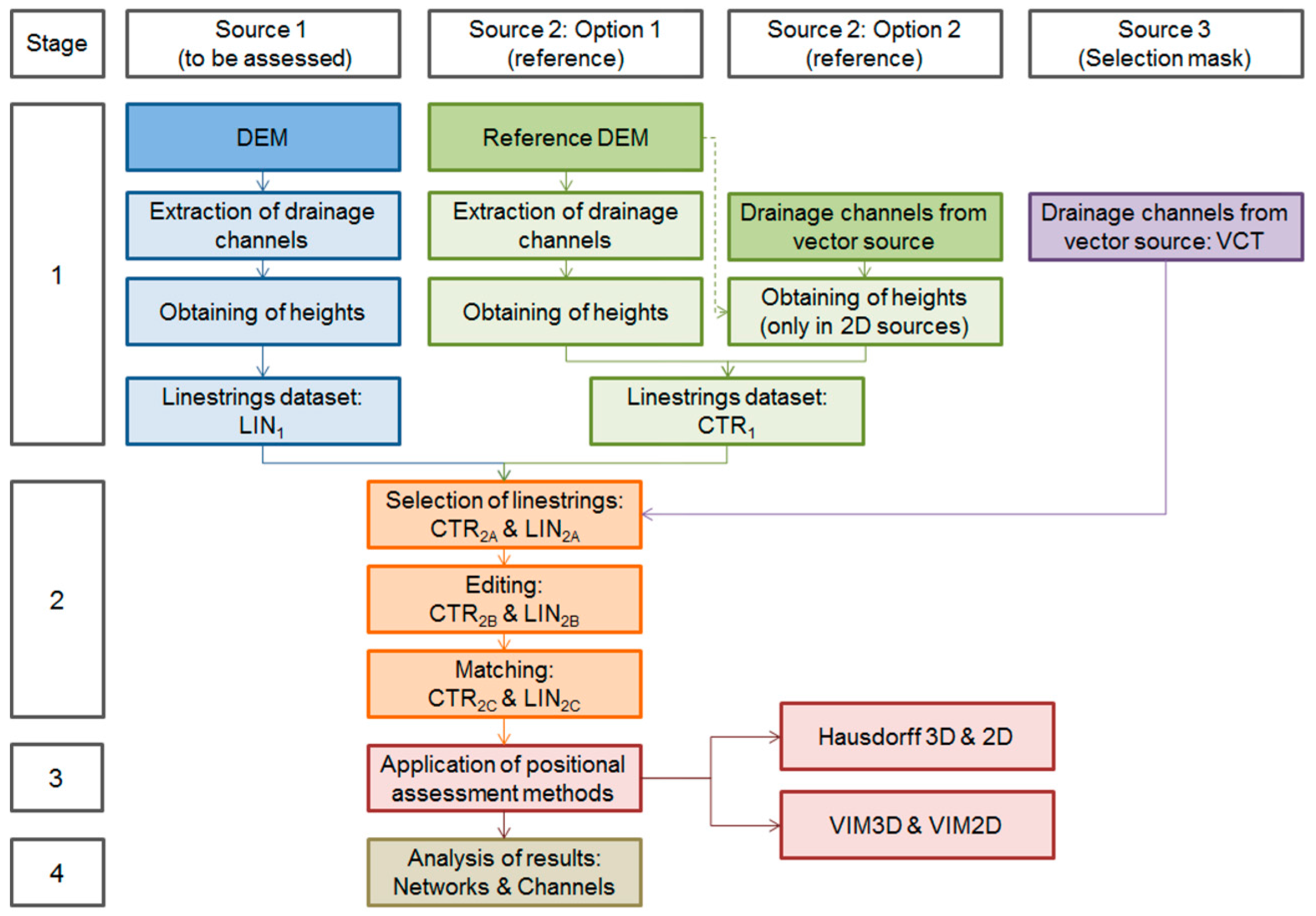
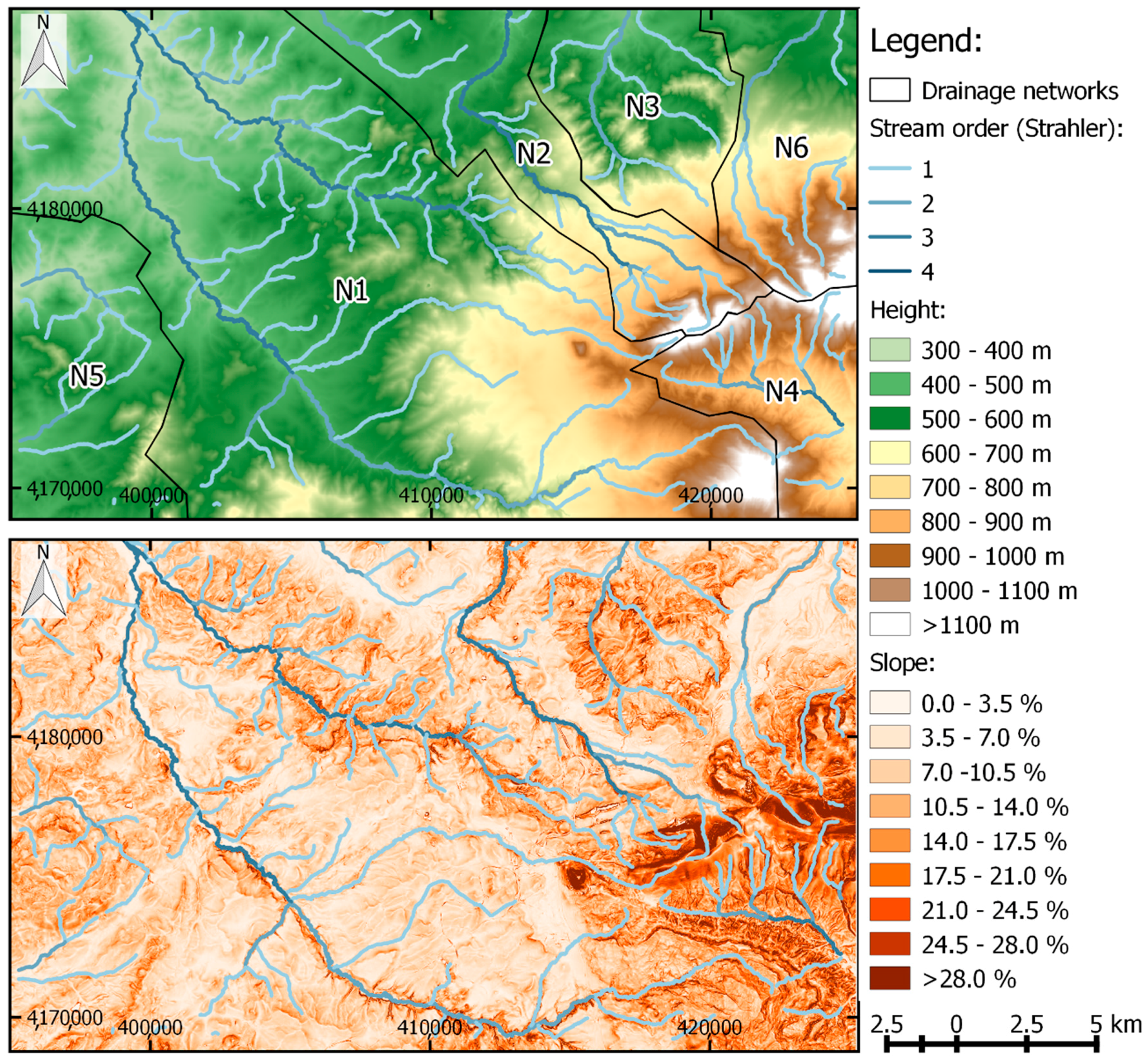
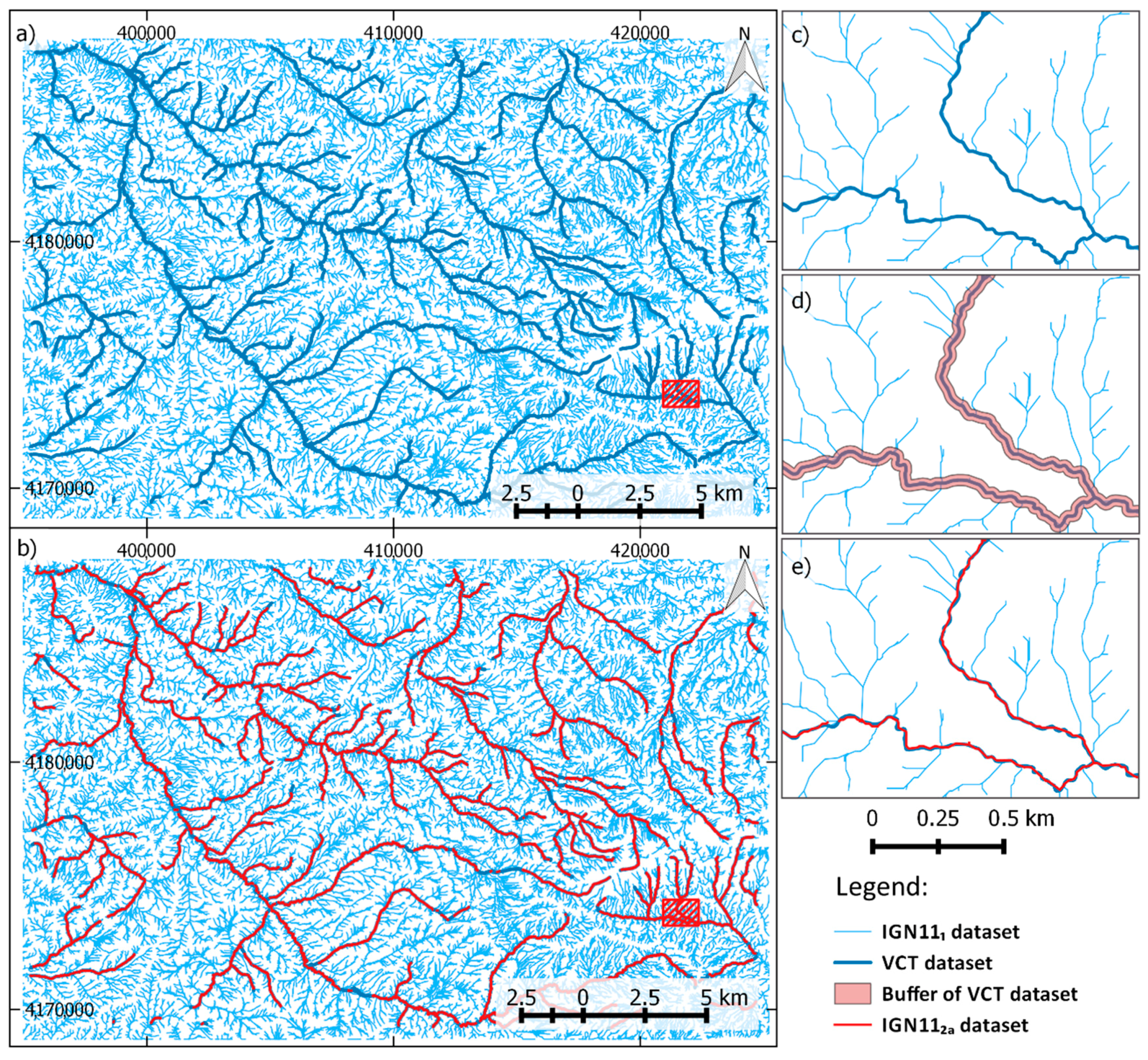
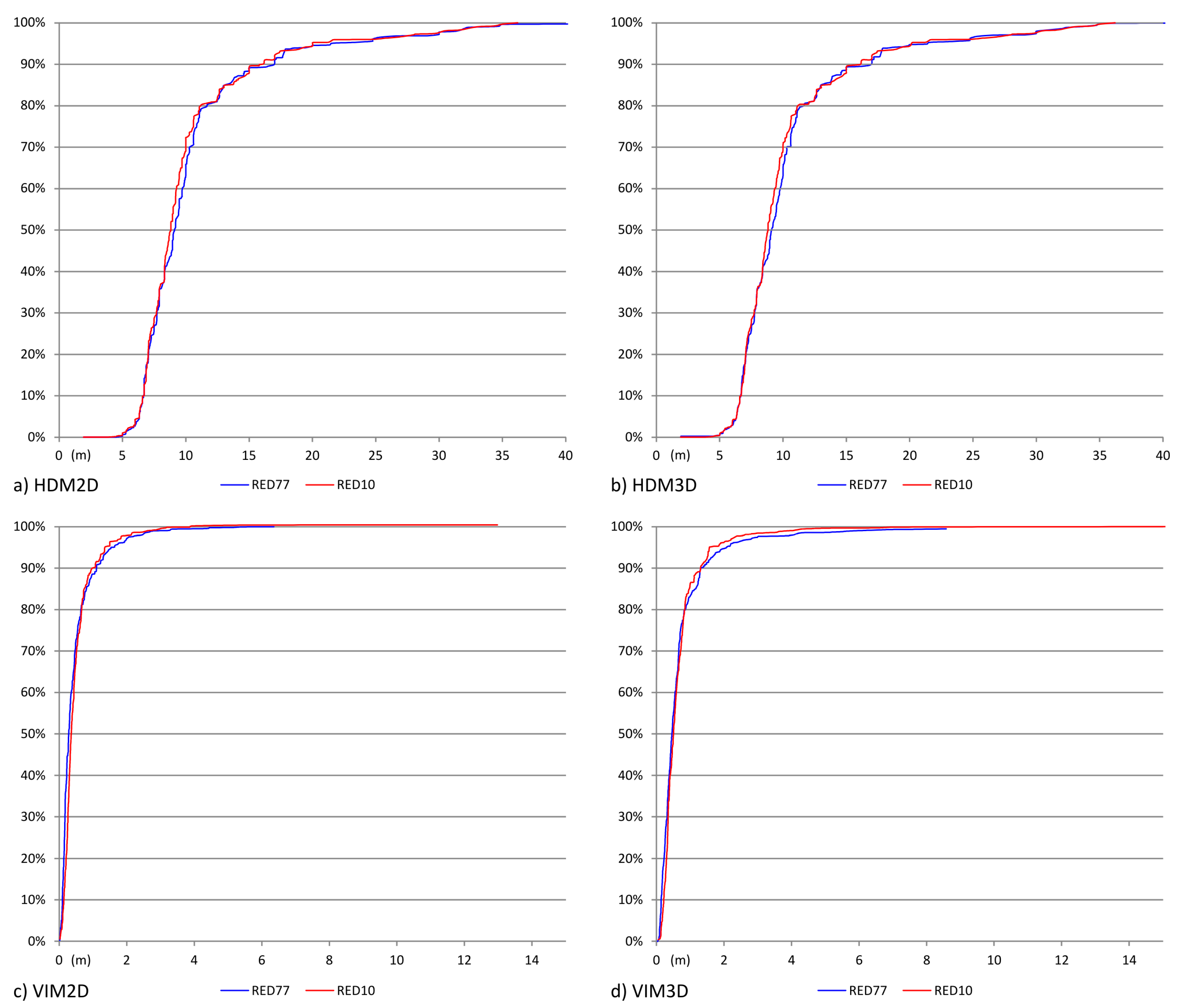

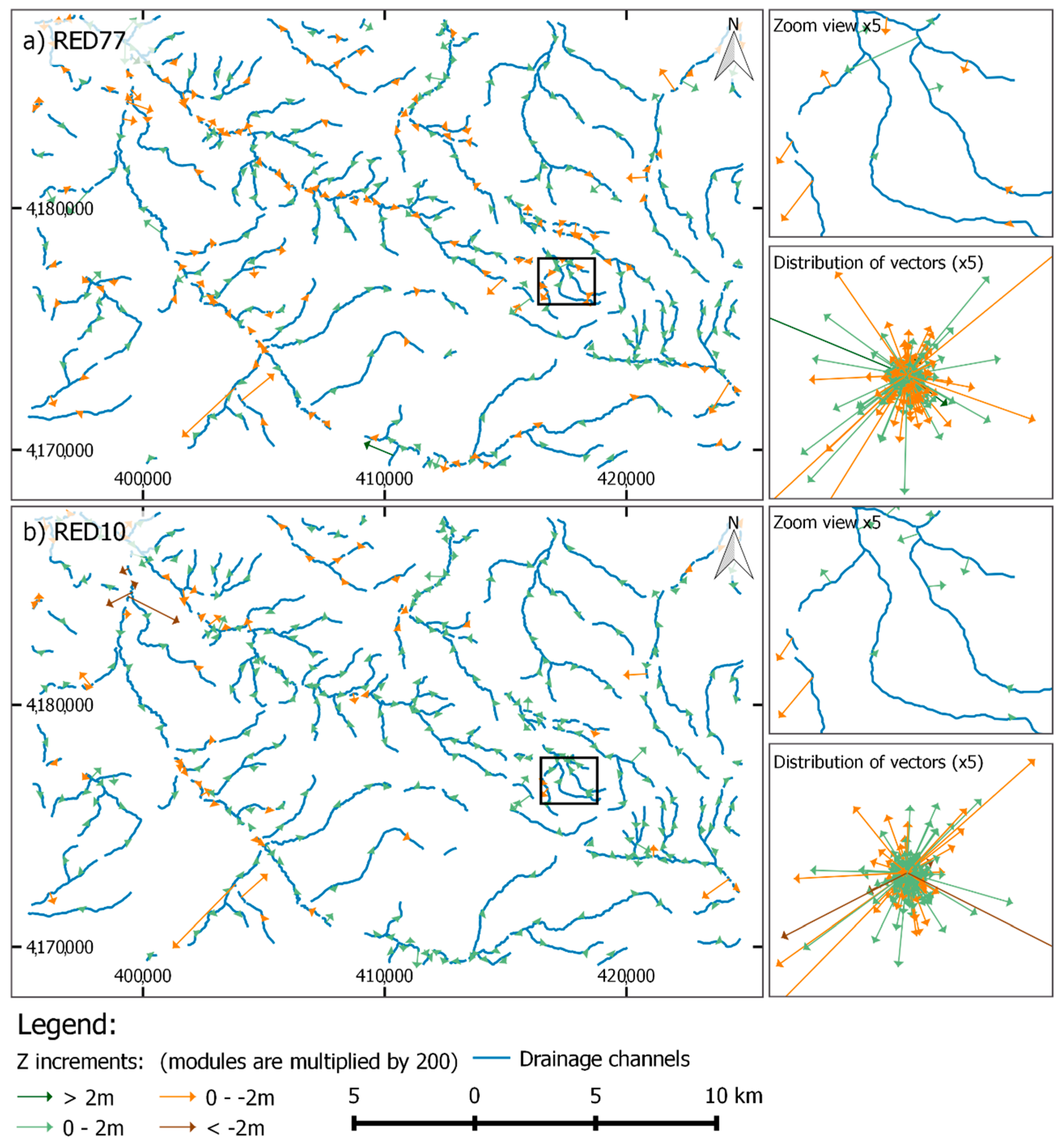
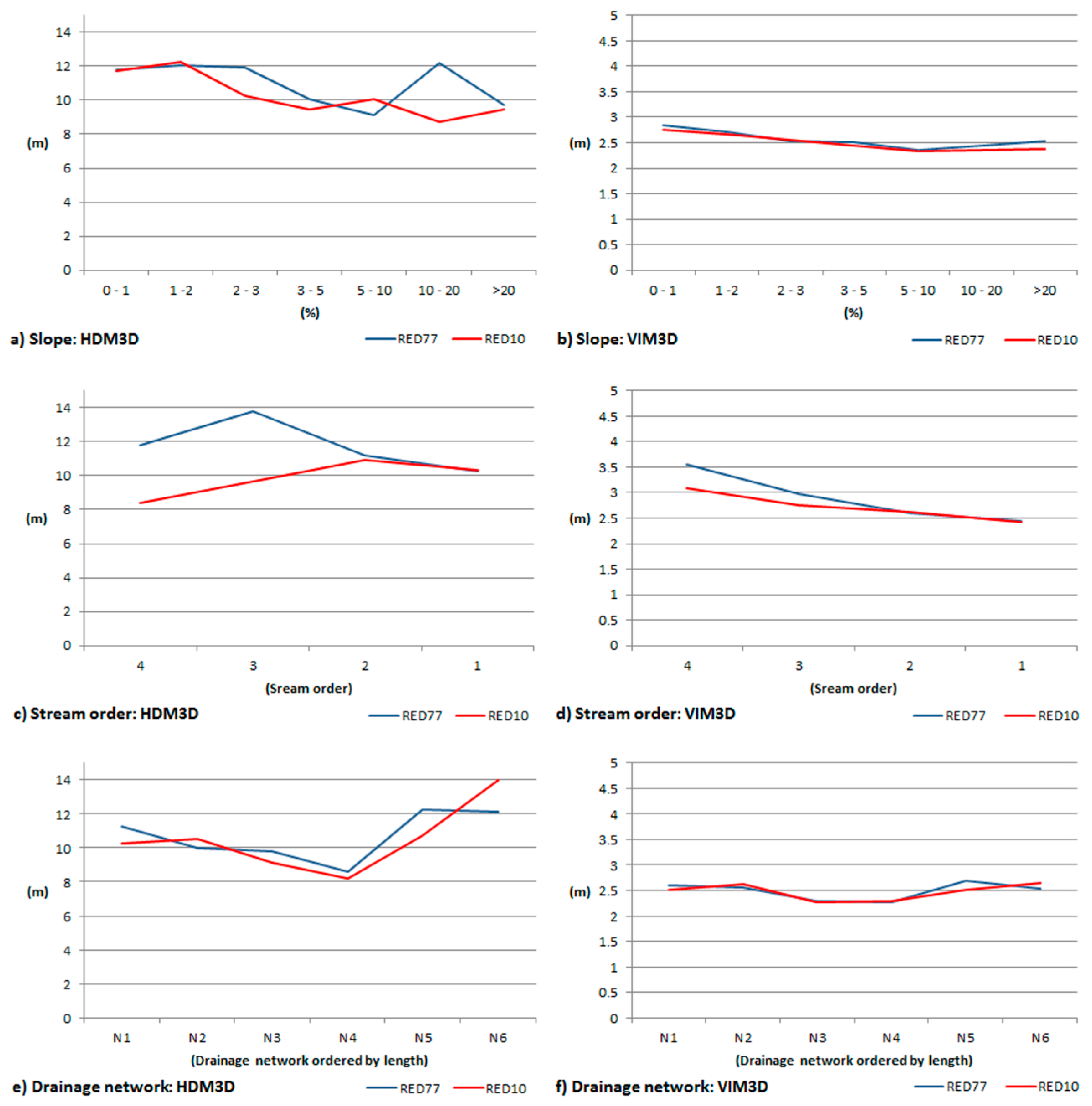
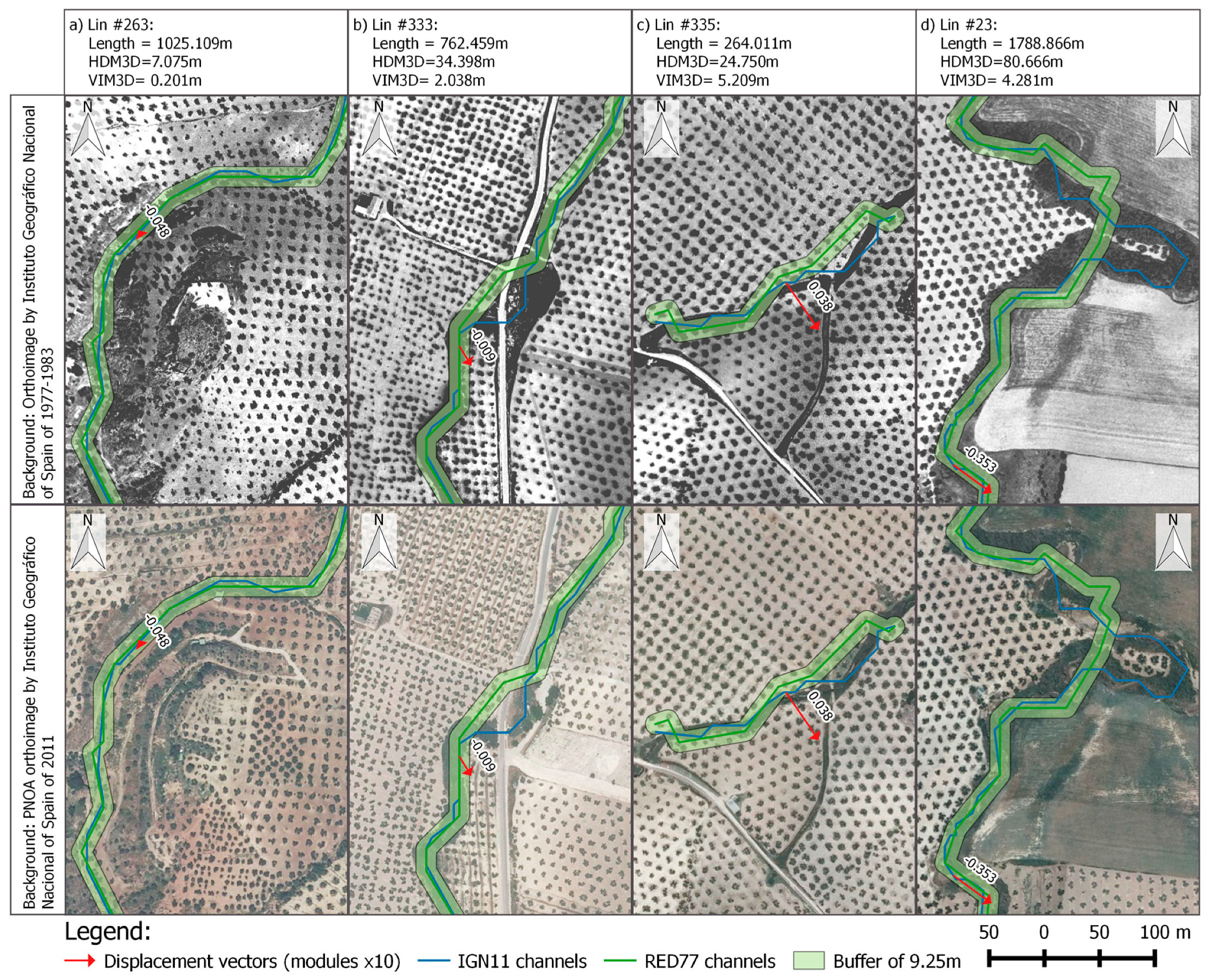
| Type | Name | Source | Features | Use |
|---|---|---|---|---|
| DEM | DEMRED77 | B&W Flight S18k, year 1977 | 10 × 10 m | Source for RED77 |
| P-RPA95% 1 = 9.253 m | ||||
| Z-RPA95% 2 = 0.406 m | ||||
| DEM | DEMRED10 | Digital Flight, year 2010 | 10 × 10 m | Source for RED10 |
| P-RPA95% 1 = 9.178 m | ||||
| Z-RPA95% 2 = 0.201 m | ||||
| DEM | DEMIGN11 | Digital Flight, year 2011 | 5 × 5 m | Source for IGN11 |
| Linestrings | RED77 | DEMRED77 | To be assessed | |
| Linestrings | RED10 | DEMRED10 | To be assessed | |
| Linestrings | IGN11 | DEMIGN11 | Reference | |
| Linestrings | VCT | Vector source at scale 10,000 | Selection mask |
| Dataset | HDM2D (m) | HDM3D (m) | VIM2D Displ. (m) | VIM3D Displ. (m) | VIM3D dX (m) | VIM3D dY (m) | VIM3D dZ (m) |
|---|---|---|---|---|---|---|---|
| RED77 (mean) | 10.825 | 10.854 | 2.505 | 2.549 | −0.038 | −0.149 | 0.053 |
| RED10 (mean) | 10.305 | 10.342 | 2.452 | 2.495 | 0.044 | −0.196 | 0.128 |
| RED77 (s) | 7.235 | 7.245 | 0.936 | 0.953 | 0.769 | 0.736 | 0.234 |
| RED10 (s) | 5.320 | 5.311 | 0.802 | 0.816 | 0.699 | 0.708 | 0.242 |
| p-value | 0.282 | 0.289 | 0.424 | 0.446 | 0.142 | 0.392 | 3.88×10−5 |
© 2017 by the authors. Licensee MDPI, Basel, Switzerland. This article is an open access article distributed under the terms and conditions of the Creative Commons Attribution (CC BY) license (http://creativecommons.org/licenses/by/4.0/).
Share and Cite
Mozas-Calvache, A.T.; Ureña-Cámara, M.A.; Ariza-López, F.J. Determination of 3D Displacements of Drainage Networks Extracted from Digital Elevation Models (DEMs) Using Linear-Based Methods. ISPRS Int. J. Geo-Inf. 2017, 6, 234. https://doi.org/10.3390/ijgi6080234
Mozas-Calvache AT, Ureña-Cámara MA, Ariza-López FJ. Determination of 3D Displacements of Drainage Networks Extracted from Digital Elevation Models (DEMs) Using Linear-Based Methods. ISPRS International Journal of Geo-Information. 2017; 6(8):234. https://doi.org/10.3390/ijgi6080234
Chicago/Turabian StyleMozas-Calvache, Antonio Tomás, Manuel Antonio Ureña-Cámara, and Francisco Javier Ariza-López. 2017. "Determination of 3D Displacements of Drainage Networks Extracted from Digital Elevation Models (DEMs) Using Linear-Based Methods" ISPRS International Journal of Geo-Information 6, no. 8: 234. https://doi.org/10.3390/ijgi6080234






